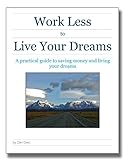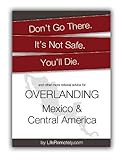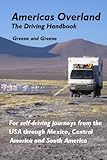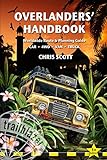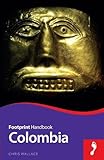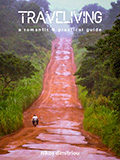Overland Colombia Travel
Pan American Highway > Colombia
Currency to display:
Contents
- 1 Visiting Colombia
- 2 Entering Colombia with a Car or Motorbike
- 3 Driving in Colombia
- 4 Gas and Diesel price in Colombia
- 5 Safety and Security Considerations
- 6 Camping in Colombia
- 7 Navigation
- 8 Special Overland Travel interests
- 9 Vehicle Maintenance
- 10 Buy or sell a car or motorbike in Colombia
- 11 References
- 12 Helpful External links
Visiting Colombia
Colombia is a beautiful country which is now much safer than it's reputation. Many Overlanders wish they could stay longer. Borders are easy.
Entering Colombia with a Car or Motorbike
Correct as of: April 2014
Required Paperwork
- Passport of registered owner (original and one copy)
- Vehicle registration (original and one copy)
- Drivers license (original and one copy)
Process at border
(To check if you need a travel Visa for Colombia, application instructions and fees see: Colombia Visa online application at VisaHQ.com)
- The owner of the vehicle gains entry at Immigration (Migración), including a stamp in their Passport.
- The owner must show the new passport stamp, original vehicle registration and original Drivers license to Customs (Aduana). Aduana may ask you for photocopies of your Vehicle Registration, Drivers Licence, Passport and Entry Stamp.
- The owner is issued a temporary import permit for the vehicle.
Import at Santa Marta Harbour (juli 2014)
- Antwerp - Santa Marta (weekly)
- Antwerp export compagny: Levaco price: €1,550.00 EUR (fiat ducato)
- shipping line Compagnia Logistica Colombiana
- import in Santa Marta: Granandino cel: 318-2662318
- 3 days process time in harbour seems to be minimum
- Total cost Granandino $800,000.00 COP
Cost of entry
Free.
Permitted length of stay
Many nationalities are allowed entry for 60 days. US citizens receive 90 days per calendar year resetting Jan 1st. The temporary import permit for the vehicle will match the duration of the owners entry. UK citizens are given 90 days. Swiss citizens are given 90 days upon entry which can be extended for another 90 days per calender year, resetting on January 1st.
Extension of stay
The following extension process was done in Santa Marta, after originally shipping the van from Panama to Colombia, 89 days previously. To extend the temporary importation permit for another 90 days a written letter requesting additional time is required. This letter can be a very simple handwritten letter in Spanish. Take this letter and a photo copy of the letter to the Dian office (CRA 5, Calle 17) to obtain the required stamps. In Santa Marta you then take these papers with the newly acquired stamps to the other nearby Dian Office at the Sociedad Portuaria (CRA 1 Calle 10). Here they will complete the required paperwork and need to inspect the vehicle, then giving your vehicle an additional 90 days, at no cost. Sample letter requesting additional time provided below.
"Santa Marta, Febrero 18 de 2013
Senores,
Dian-division de gestion de la operation aduanera la ciudad Importacion temporal de vehicle de tourista.
Por medio de la presente solicito a ustedes prorroga de la autorizacion inicia no XXXXX (Number and date found on your original import paperwork) de Nov. 21 de 2012, expedida en la direccion seccional de aduanas de Cartagena, para el vehiculo Chevy Astro con numero de chasis XXXXXXXXXXX (for American vehicles insert your VIN number here) de color beige y ano de fabricacion 2004.
La autorization inicial vencera el XX/XX/XXXX (date your original importation expires) por consipuiente solicitio a ustedes una pronta repuesta a esta peticion.
Atentamente,
Signature
Full Name
Passport No. XXXXXX"
The following documentation package was created in early 2014 explaining how to extend your personal visa and vehicle permit in Medellin http://www.pawsontour.com/iea/DOWNLOADS/Grenzuebergang/Immigration_Visum_Colombia.zip
Beware (Medellin sept 2014): Temporary import can never be longer than the time allowed in your pasport (mostly 90 days after your entry). Medellin immigration refuses to renew your 90 days if your original stamp is still valid for more than 8 days. So we couldn't renew our temporary import because our immigration stamp was still valid for another 20 days. We left the country without our car and will have to pay $550,000.00 COP for every month of overstay.
Storing a vehicle and temporarily leaving the country
Storing vehicle and leaving country is possible.
At Renacer Hostal in Villa the Leyva vehicles can be stored at $150,000.00 COP per month.
Exiting with a vehicle
By land to Ecuador
- The registered owner presents the temporary import paper to customs.
- The registered owner is stamped out of Colombia at immigration.
By ship, probably to Panama
See Crossing The Darien Gap for details.
Driving in Colombia
For a great overview, see: Driving in Colombia - fromAtoB.org
Insurance requirements
Insurance is mandatory in Colombia, and Police will most likely ask to see it. Like many South American countries, the insurance is called SOAT (Seguro Obligatorio Automóviles Transito).
Cost of insurance
Varies with the size of vehicle and size of the motor. Around $82.00 USD for two months for a 4x4.
Land Rover Defender 300Tdi 4x4 SOAT purchased in Ipiales was $75,000.00 COP in May 2013
1 month for approx. $80,000.00 COP for a 4 cylinder 2.5l van in Feb 2014 - you might need to check multiple insurance vendors to get 1 month insurance and/or possibly "modify" you temporary import permit to show less days allowed in Colombia. Otherwise the insurance company may claim they will only insure for the full length of the temporary permit. The police do NOT mind seeing insurance for 1 month and temporary permit for 3 months - they are usually surprised you have insurance at all.
Where to purchase insurance
Insurance brokers are common in even the small towns and and usually affiliated with banks. Ask around for "SOAT". You can find one on the 2nd floor of the white building found between Old Town and Getsemani in Cartagena - N10 25’30.6” W75 32’52.8”
Another place in Cartegena that sells short-term (one month) is close to the old town. It can be found at Avenida Carlos Escallon, in the building of Banco Bogota, marked as "Comfamiliar" (large metal doors), in the 8th floor (elevator goes only to 7th). GPS roughly 10.423875 -75.54865.
Santa Marta: Lyberties , plazuela 23, calle 23. Ask for Tatiana. Minimum 3 months.
Driving license
Technically an International Driving Permit is required.
In reality, showing a license from anywhere in the world seems to be good enough.
Driving side of road
Right,
Right hand drive vehicles are permitted without problem.
Mandatory items in vehicle
None.
Roads
General Road quality
Roads in Colombia are generally sealed and good quality. If you venture into the interior, expect gravel roads that may be impassable in the wet season. Minor roads in the mountains have a lot of "hundiamentos"; half of the road disappearing or with important prolapses. After heavy storms a lot of stones on the road.
Road signs
Road signs are common on highways and in towns. It's usually not too difficult to find signage to get where you are going.
Toll roads
All bigger highways are tolled in Colombia. Expect to pay roughly $5.00 USD every 100km or so.
Bribery in Colombia
Police bribery is refreshingly far less common in Colombia than in surrounding countries, and it's very unlikely that you will encounter it on the main roads. The Colombian tradition of police corruption is very much supply side, involving Colombians cautiously trying to get out of fines or jail time, not police seeking to intimidate people into giving them. When people are stopped by police/military seeking money, it's usually pretty unintimidating—a sort of weird asking for help with gas money.
Because of the security history of Colombia, police/military are everywhere along the roads, and you should expect to be waved over with some frequency. This is not a big deal. They will take a look at your car, ask you who you are (they rarely ask for identification, if you are clearly a foreigner), and then wave you on. They have a serious mission to look for criminals/rebels, and aren't interested in tourists beyond a friendly curiosity.
There is a campaign of sorts to emphasize that the military is on your side. Flash a thumbs up at the police/military checkpoints, and they will give you a thumbs up in return, and are less likely to pull you over!
See the bribery tips page for general advice.
Checkpoints
Police and Military checkpoints are common in Colombia. You will be asked to present your Passport, Vehicle registration, drivers license, the temporary import permit you were issued at the border and your SOAT insurance. Driving without the required SOAT insurance is a sure-fire way to encounter bribery. Tourists are rarely stopped. Police is very friendly. Army is very young. (3 times stopped in 4 weeks, 2000 km, ~100 checkpoints)
Traveling with pets
If you enter via road or boat it seems that nobody seems to care about pets. If you enter via airport (Panama-Colombia for example) it gets very complicated and you need to have lots of requirements! This travelers have a detailed document how they did it in January 2014: [1]
Gas and Diesel price in Colombia
Last updated: December 2012 (Diesel Aug 2014)
Prices can vary throughout the country by as much as 50%!
Diesel is often called ACPM (Aceite Combustible Para Motores, means Combustible Oil for Engines).
Riohacha, Maicao and Uribia (all in the Guajira) have 40-50% cheaper gas & diesel at official gas stations! If you buy it from the street (not legal) it's even cheaper! Same for Cucuta.
When coming from Cartagena and going to Medellin, before you get to San Jacinto the gas was also around 15% cheaper! (around $3.60 USD per Gallon (US) in Feb. 2014 instead of $4.00 USD per Gallon (US)) Same for the road from the coast down to Bucaramanga you will see gas stations with much cheaper Diesel.
Also when going from Bogota via Honda you can get 5-10% cheaper gas because they got a petrol plant there.
We found Diesel in the far South to be much less expensive than the Midlands and North, around $3,000.00 COP per Gallon (US) LESS. Possibly due to the proximity to Ecuador where its much cheaper still.
Close to the venezuelean border illegal fuel is very common, half price from street sellers. (aug 2014)
Currency and unit to display:
| Gasoline Grade | Min Price | Max Price |
|---|---|---|
| Plus/Corriente | $4.80 USD per Gallon (US) | |
| Premium | About $5.82 USD per Gallon (US) | |
| Diesel | $3.60 USD per Gallon (US) | $4.50 USD per Gallon (US) |
| Diesel | $7,000.00 COP per Gallon (US) | $8,800.00 COP per Gallon (US) |
Gas and Diesel Availability / Frequency
Gas stations are extremely common in Colombia, and shortages are not common.
Gas and Diesel Quality
Gasoline and Diesel are generally thought of as good quality. There are some gas stations that offer Biodiesel. The sulfur content of diesel should be since 2013 by law max. 50ppm. Diesel in Colombia contains 10% of biodiesel (B10).
Fuel from nearby Venezuela is easy to buy from roadside vendors near the border. The quality of Venezuelan fuel is higher and it can be purchased for less. Use caution as the fuel is often sold in weak plastic containers which is not safe for fuel storage.
Safety and Security Considerations
Driving at night
Everyone will discourage you from driving outside the cities at night, principally because the roads are dark, and accident rates are high.
The mountainous roads in the Andino region, which include major routes like Cartagena–Medellín, Cartagena–Bogotá, Medellín–Bogotá, Bogotá-Cali, and Bogotá-Santa Marta, can be very dangerous for simple reasons of topography. The winding, steep, two-lane roads slow trucks down to a snail's crawl, which makes for constant passing with little visibility around curves. You will have to worry both about your own passing and the potential for oncoming traffic constantly. At night these roads are very dark, fog is common, and rain will make it nearly impossible to see. There are few places to pull off, and even fewer lodgings near the mountain passes. La Linea de la Alta on the Bogotá-Cali road is notoriously dangerous, with a steady stream of fatal accidents at night.
Any time you consider a drive in the mountainous regions, start the trip as early as possible, and budget twice the amount of time you expect the drive will take—you don't want to do this after dark.
In certain sections of the country, driving after dark is unsafe because of political/security instability, with the potential for paramilitary roadblocks. The most well-traveled area for foreigners for which this applies is southwest, Atlantic departments: Cauca, Valle del Cauca, and Nariño (around Cali and Popayán). Another well-traveled, albeit smaller, area of concern is the Magdalena Department west of Santa Marta. You probably would be OK driving at night in these regions, but if you place a high value on your life, it's best not to risk it.
Vehicle parking
Auto theft is a very big problem in Colombia. Parking vehicles on the street in smaller towns during the day is usually OK, but a parking lot is still a good idea. Consider it absolutely necessary to park in a secure lot anywhere at night, and any time of day in the big cities. Medellín, in particular, is a notoriously bad place to park on street. Cost is something like $1.00 USD to $2.00 USD per night.
Special driving considerations
While the roads are well maintained (thank the expensive and frequent tolls), they get washed out and can become impassable during the rainy season. Because of Colombia's wildly varied topography, rainy seasons occur at different times of the year in the different topographic zones. Whenever possible, let locals know where you are going, and ask about road conditions. Pay attention to the TV news when its on, as the reporting on floods is very good.
Colombians are one of the nicest people you will meet on this trip, but by far one of the rudest drivers! They will overtake you in any turns, no matter how dangerous it is! So be very prepared to brake and always think for the other driver too, because they usually don't!
Security advisories and information
- Country Specific Information - U.S. Department of State
- Travel Reports and Warnings - Foreign Affairs and International Trade Canada
- Travel advice by country - Foreign and Commonwealth office (U.K.)
- Travel Advice for Colombia - Australian Department of Foreign Affairs and Trade
Camping in Colombia
Camping is not very popular in Colombia, although many "hoteles campestre" do have a camping site. Most of the time this is only a grass field. Locals do use them on friday and saturday night. Few hostels in touristy areas have camping to cater for backpackers. A few of the larger parks and reserves allow camping for a nominal fee. Choose roadside camping sites carefully. Camping plots are rarely reachable by car. It's easy to ask people at small finca's to use their garden (do not refuse the "tinto" they normally offer)
Camping guide books
Unknown.
Drinking water
Tap water in Colombia is generally not safe to drink outside Bogotá, Cartagena, and Santa Marta. Ask around some villages in the mountains have excellent drinking water, without the bad treatment taste.
Signage
Signage is always there, but it's not necessarily that good. Route markers are not used, and the route numbers are not well known. Instead, all signage is done by listing upcoming cities and towns. Towns are usually on access roads off the highway, so it's good to follow signs for the town past the next one on your route, rather than the first one you expect to find. E.g., if you are driving southwest from Bogotá towards Cali, and the next signed place is Fusagasugá, aim to follow the signs for the destination past that (Melgar, Ibagué, or Cali).
Paper maps
Reise Know-How and Freytag & berndt are amoung the best paper maps. Purchase paper maps before arriving in Colombia
- For a high quality road map, buy before you get to Colombia.
- Reise Know-How Maps are highly recommended, they are updated yearly. Order directly from the German website to ensure you have the latest version. [2]
GPS Maps of Colombia
- Open Street Map: Have good coverage, only some minor roads are lacking. New dual carriage roads and ring-roads are rarely on the map.[3] But remember that the route numbers are rarely found on any signage.
- Garmin: Lists "Detailled" converage.[4]
- TomTom: No map of Colombia. [5]
- Colrut: Probably the best free GPS map of Colombia updated often and includes tracks and trails [6]
GPS co-ordinates for camping, propane, gas, repairs, etc. in Colombia
- Places in Colombia - Camping Places & Sights in Colombia from Pawsontour
- Places in Colombia - Camping Places in Colombia from AtoB.org
- Spectacular Places to Camp in Colombia - fromAtoB.org
- Campgrounds (and Hotels) - Life Remotely
- Camping Sites: Colombia - Detailed list of campsites and propane filling with description, directions and GPS co-ordinates. Some at hotels (lists facilities and price), some roadside and free.
- Campsite Listing - South America | PanAm Notes - List of campsites, with directions and GPS co-ordinates. Some at hotels (lists facilities and price), some roadside and free.
- Andes Expedition camping Locations - List of campsites, with basic directions and GPS co-ordinates. Mostly free sites.
- Camping Log 2: South America - List of campsites, shopping, fuel, propane and border crossings with excellent descriptions and GPS co-ordinates.
- Hackney Travel SA Waypoints - Raw GPS data (in gdb or gpx format) for waypoints (including campsites, fuel, repairs, propane and more)
- The Silk Road Motocaravan Network - Raw GPS data for waypoints (camping, gas, propane, points of interest and more)
Special Overland Travel interests
None.
Guide Books
- Colombia Facil Travel Book - Very small, but really good and very cheap guide book with tons of information! You can get them at many hostels.
Vehicle Maintenance
Dealers
4x4s / Trucks
- Toyota Global Dealer Locator
- Land Rover International Dealer Locator
- Mercedes Benz International (select country on bottom right)
- Jeep International site locator
Motorbikes
Local Garages
Add known good mechanics here.
Buy or sell a car or motorbike in Colombia
Buy
Unknown.
Describe how a foreigner can buy a vehicle.
List any difficulties or limitations on where the vehicle can be driven.
WSell
Unknown.
Describe how a foreigner can sell a foreign-plated vehicle, or list not possible.'
References
- ↑ Dog requirement when flying from Panama to Colombia
- ↑ Reise Know-How Maps
- ↑ OpenStreetMap Colombia
- ↑ Garmin coverage map
- ↑ TomTom Map availability
- ↑ Colrut Open Source Maps of Colombia
Helpful External links
- Colombia: Visa and Passport requirements | World Travel Guide
- Health Information for Travelers to Colombia - Center for Disease Control and Prevention
- Colombia travel guides at wikivoyage
- Colombia - Wikipedia, the free encyclopedia




